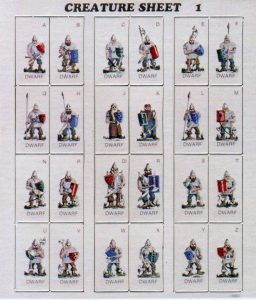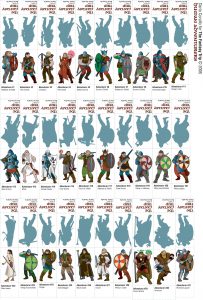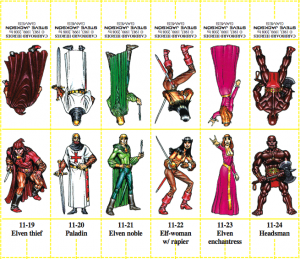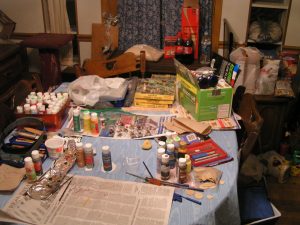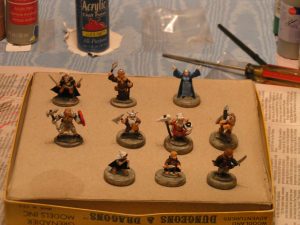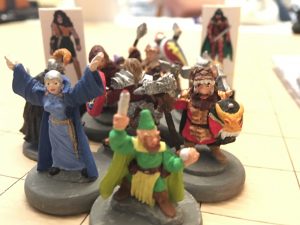While fantasy role-playing games (FRGs) can be played merely by saying what everyone in the party is doing, most groups end up using some kind of miniature figures to mark the location of the character in certain situations. When I first started playing Dungeons & Dragons way back in 1979, players just gave verbal descriptions of where their character was located, especially in battles. Then we started using Legos and Lincoln Logs to mark the location of rooms and hallways, and used any kind of markers that were handy, such as coins, bottle caps, dice, etc, to mark where different characters and monsters were located.
Then I discovered “Zargonian Creatures,” which were 2-dimensional cardboard standup figures that slipped into plastic bases. When punched out of their cardboard frame, each (standard-sized) figure is 1.5 inches tall and 0.75 inch wide. You can find some of the Zargonian sets on eBay, but about the only place I found that still has stock on the original sets is Noble Knight Games.
However, when I stopped playing D&D in 1982, I loaned all of my Zargonian figures to a friend, and never asked for them back. Then, when I got back into playing D&D recently, I tried to track down that old friend, only to sadly find out he had died about 4 years before I tried to contact him. I was trying to contact him for 2 reasons, one, to try to get those Zargonian figures back, and two, to try to enlist him in the new D&D campaign, as he was a good D&D player. But neither of those was now an option.
Well, I still had several sets of plastic bases from the Zargonians, so I started using various cardstock figures that I could print on my color laser printer. These figures could be folded over and glued, and then inserted into the Zargonian bases. I found that most two-thickness cardstock was not thick enough to stay firmly stuck in the plastic bases, though, so added a few more layers of cardstock at the bottom of the figures so they would stay attached to the bases when you picked them up by the figure. There are plenty of places online to find various printable cardboard figures. Two of my favorite places to get cardboard figures are the Darios figures at Dark City Games, which are free, and the paid Cardboard Heroes from Steve Jackson Games.
The Darios and Steve Jackson figures also have some advantages over the old Zargonians in that they are two-sided, and you can tell a character’s front from its back. The Zargonians were just blank cardboard on their backs and so it was hard to tell which figure was which. The newer figures also have much more detail in their drawing, which is probably partly because the printing technology is better today.
There are various places you can buy plastic or wood bases for the cardboard figures online, also. The cardstock figures are good, too, for when you need a lot of some particular type of character or creature as you can print off extra sheets.
But recently I got into using some metal miniatures. I somehow or other accumulated about 5 or 6 metal (25mm or 28mm) miniatures over the years. I believe I accumulated them when helping the Metro Detroit Gamers clean up the venues at the end of their game conventions, finding them left behind on the floor. (I also own exactly one card (the Forest) for Magic: The Gathering, having also found that card on the floor while cleaning after a game con.) But I got the chance to buy about 40 or 50 old metal miniatures recently for only $10. They are mostly old Grenadier minis, but one set was from Ral Partha (although the figures were all intermixed). So then I borrowed my sister’s acrylic craft paints and started painting away. Fortunately, I am an old model builder from way back, although I haven’t painted anything for years, especially not anything as small as these figures.
I did read up on some mini painting techniques at the excellent web site at http://www.how-to-paint-miniatures.com/. I did wash the figures thoroughly, even had to remove some old paint using 91% isopropyl alcohol and a toothbrush (using an old aluminum pie pan). Of course I wore a latex examination glove to keep my skin oils off the minis. I then glued the minis to wooden bases, then painted each figure and its base with white acrylic primer, then after the primer was dry started painting. I kept using an exam glove on the hand that was holding the figure I was painting.
We then finally started using the metal minis in our D&D campaign on July 24, but only for the main characters. For NPCs and monsters we’re still using the cardstock figures. Here’s a picture taken by one of our players on their cellphone of the metal minis all bunched up. There are a couple of the cardstock figures in the background.
The three figures in the front are (from L-to-R), Opalent, Lightstep, and Vandin. Lightstep is not yet finished. I haven’t yet painted his eyes, nor some of the trim on his clothing and accessories.
Anyway, painting the minis is fun, although it can take a lot of time. I can only paint for about 30 minutes at a time, then my neck gets sore from being bent over. I have to use an Optivisor in order to see close enough to paint, and have to sometimes hold the figure and the brush close to my body to prevent wobbly painting. That’s what bothers my neck, as I have to lower my chin to my chest in order to focus with the Optivisor. When I was building models in my 20s, I had 20/13 vision (better than 20/20). I used to scoff, hah! who would need magnifying lenses! But when I hit my mid-40s, I suddenly noticed I had presbyopia and I needed reading glasses. I also found I needed stronger magnification in order to see fine details. I probably should buy a desktop lamp with a large magnifying lens, then I might not have to bend my neck so much.
— The Dungeon Master
